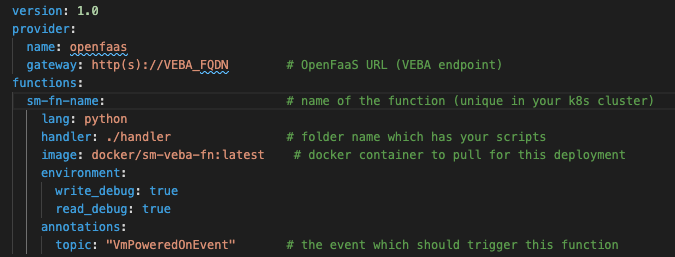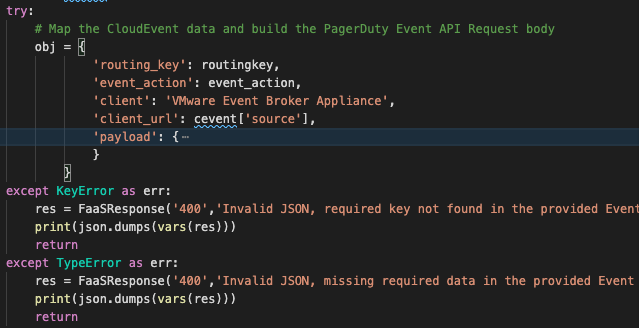Writing your first Serverless Function
A function is a unit of execution in the Serverless world that does one thing and one thing really well. With the current product VMware Event Broker Appliance (VEBA) that i’m managing, we aim to provide a simple solution that provides a way to execute your functions driven by vCenter events. This is a significant capability that exposes a plethora of integrations and allows seamless automation opportunities for a VMware SDDC customer.
As the Product Manager, I wanted to take the opportunity to write a function not only to contribute and help the team but also as an effective way to understand one of our persona that we are targeting — developers and especially the ones that are new to programming. This exercise of building a function gave me several insights as well as enabled me to learn more about our product and the underlying tech capabilities and constraints. Here is my account of my experience and learnings!
Development Setup
OS: macOS Catalina
IDE: VisualStudio Code
Version Control: Git
Language of choice: Python (no prior professional experience but have dabbled with it a few times)
FaaS Platform: VEBA deployed with OpenFaaS. Alternatively, you could have OpenFaaS running on Kubernetes w/ VMware Event router container deployed to get the same functionality
vCenter: Required since our functions will be driven by events generated within the SDDC. I have a homelab that i can work with for testing purposes.
Function Execution Flow
VMware Event Broker Appliance deployed with OpenFaaS makes it easy to write functions and before we start writing the function, it’s good to get a visualization of what the function execution flow look like.
The VMware Event Router streams the events from vCenter, packages those events into CloudEvent spec and invokes the appropriate function when it sees the right event.
The Event is passed to OpenFaaS as a http request which then invokes the function passing the event down as a std input argument which you can read and start building your business logic.

OpenFaaS provides readily available templates that you can use to get started and also has workshops that you can also use as a resource.
Writing the Function
For my first function, i’m going to trigger a Pagerduty incident upon an event in vCenter. After some quick research, i was able to setup Pagerduty with a developer account, nailed down the API that i want to call and also decided on using the VM Power On/Off event to trigger an incident.
Hello Serverless
Now before jumping into the code itself, i spent some time putting together a minimal structure to get the function working and doing something simple— such as printing the event passed down to my Function. This is what the file structure looks like..
|
|
A version of this is available within the examples folder of the VMware Event Broker Appliance github repository here.
|
|
Now that you have this folder cloned, let’s get started..

stack.yml — this is the primary descriptor file which we are going to use to deploy the function. I made modifications as my environment required. A sample shown below..

handler.py— this is the core python file that should have the business logic for my function. This is what it looks like to start with..
README.md— this file contains the documentation describing the function purpose as well as steps to deploy the function
With this minimal code, I proceeded to deploy this code to OpenFaaS on VEBA. You can do this by using the deployment steps provided in the README.md file here
Here we go..
Once I got comfortable with the deploying this simple function and seeing it execute, i proceeded with making the next iteration of changes and make our API call. These set of changes are available in the VEBA Github examples repository.
A templatized version of this updated function is available here for you to get started that you can get as shown below
|
|
For my function to trigger a PagerDuty incident, i needed the following for the API call (more details here)

While the API URL seems static and the other configurable information can be setup to be passed as a config to my function. This is done by using the secrets keyword within the stack.yml as shown to the left.

The config file is a json (can be any other format) with the details about the routing key and the action for the API and is structured as shown to the left.

As we need to make http requests, we need the necessary libraries which can be specified in the requirements.txt file within the handler folder.
With these files in place, I’m now ready to write my core business logic in the handler.py file using the approach below
Pseudocode
- Parse the CloudEvent provided as stdin variable to JSON
- Read the Configuration file - /var/openfaas/secrets/pdconfig
- Validate the above input data as needed and build the API body
- Make the API call to the PagerDuty endpoint
Start Coding

1. Parse the CloudEvent
This step was already explored in the earlier steps shown above where we parse the raw text to json with exception handling to catch non-json formats

2. Read the Configuration file
The config is made available to the function at the location /var/openfaas/secrets/<configname> within your container
Here we are reading the Config file that is made available to our function under the location. I’m parsing this file and also validating that the file has the config that are required for this function to work successfully.

3. Validate Event and Config + Build API Body
In this section, we are attempting to build the API body as well as validating if the Event has all the keys that my function needs. If the keys are not available (because the fn gets an different event than what it was coded for), then we handle the exception
4. Make the API call

Finally, we are ready to make the API call with the URL and the body that we have generated. We are also catching any unhandled exceptions that may occur in this process. Don’t forget to close the session.
Wrap Up
Thats it! We now have a FaaS fn ready for testing and deployment. You can utilize the unit tests that I’ve provided in the handler.py or alternatively deploy the function using the README.md file to OpenFaaS hosted on VEBA.
Let me know if you’ve found this helpful. In the next post, i’ll provide the next iteration of changes that will help our function be more clean, debuggable and robust with the help of some util functions and best practices.
Happy Eventing!




